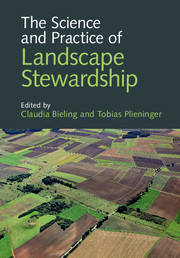Book contents
- The Science and Practice of Landscape Stewardship
- The Science and Practice of Landscape Stewardship
- Copyright page
- Contents
- Contributors
- Preface
- 1 The Emergence of Landscape Stewardship in Practice, Policy and Research
- Part I Foundations of Landscape Stewardship
- 2 Ecological Foundations of Landscape Stewardship
- Case 1 The Blackwater SAMOK Project – A Catchment Management Approach
- 3 Human and Social Dimensions of Landscape Stewardship
- Case 2 Landscape Observatory of Catalonia – A Holistic Documentation of the Landscape
- 4 Building Partnerships for Landscape Stewardship
- Case 3 Olive Farming on Lesbos – Out of Social Capital Emerges Social Enterprise
- 5 Citizen Science Tools for Engaging Local Stakeholders and Promoting Local and Traditional Knowledge in Landscape Stewardship
- Case 4 Citizen Science – Harnessing the Expertise of Farmers to Monitor Biodiversity in Austrian Meadows
- Part II Landscape Stewardship on the Ground
- Part III Visions Towards Landscape Stewardship
- Index
- References
4 - Building Partnerships for Landscape Stewardship
from Part I - Foundations of Landscape Stewardship
Published online by Cambridge University Press: 05 July 2017
- The Science and Practice of Landscape Stewardship
- The Science and Practice of Landscape Stewardship
- Copyright page
- Contents
- Contributors
- Preface
- 1 The Emergence of Landscape Stewardship in Practice, Policy and Research
- Part I Foundations of Landscape Stewardship
- 2 Ecological Foundations of Landscape Stewardship
- Case 1 The Blackwater SAMOK Project – A Catchment Management Approach
- 3 Human and Social Dimensions of Landscape Stewardship
- Case 2 Landscape Observatory of Catalonia – A Holistic Documentation of the Landscape
- 4 Building Partnerships for Landscape Stewardship
- Case 3 Olive Farming on Lesbos – Out of Social Capital Emerges Social Enterprise
- 5 Citizen Science Tools for Engaging Local Stakeholders and Promoting Local and Traditional Knowledge in Landscape Stewardship
- Case 4 Citizen Science – Harnessing the Expertise of Farmers to Monitor Biodiversity in Austrian Meadows
- Part II Landscape Stewardship on the Ground
- Part III Visions Towards Landscape Stewardship
- Index
- References
Summary
- Type
- Chapter
- Information
- The Science and Practice of Landscape Stewardship , pp. 57 - 77Publisher: Cambridge University PressPrint publication year: 2017
References
- 4
- Cited by

